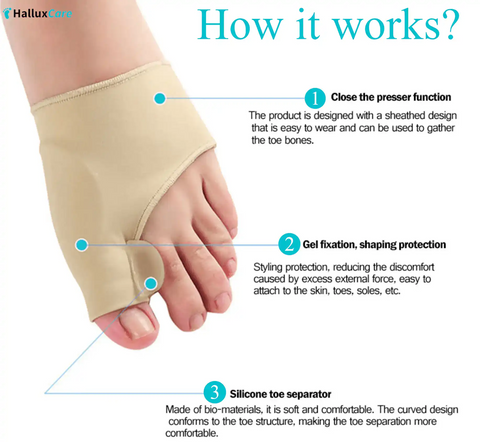Everything You Need to Know About Bunions: Causes, Treatments, and Relief Options
Last Updated: January 7th, 2025
Author: Dr. Emily Harper, DPM
Dr. Harper is a board-certified podiatrist with over 15 years of experience specializing in foot and ankle disorders. She is a contributor to leading medical journals and an advocate for patient education in podiatric care.
---
Bunions are a common yet often misunderstood foot condition that can significantly impact your daily life. If you've developed a painful, bony bump at the base of your big toe or feel discomfort while walking, you're not alone. According to the American Podiatric Medical Association (APMA), over 23% of adults aged 18–65 experience bunions, with the prevalence increasing in older populations.
This guide explains the causes, symptoms, and treatment options for bunions, incorporating expert advice, the latest medical resources, and practical tips to help you find relief.
---
Key Takeaways
- Bunions are bony deformities that form at the base of the big toe, often caused by genetics, poorly fitting footwear, or underlying medical conditions like arthritis.
- Non-surgical treatments like bunion sleeves, orthotics, and lifestyle changes can help manage symptoms and slow progression.
- Surgical options are available for severe cases but require a longer recovery period.
- Early intervention is crucial to prevent complications like hammertoes, arthritis, or chronic pain.
---
What Are Bunions and Why Do They Happen?
A bunion, or hallux valgus, occurs when the big toe begins to lean toward the second toe, causing the joint at the base to protrude outward. Over time, this misalignment can lead to swelling, redness, and pain.
Common Causes of Bunions
- Genetics: If bunions run in your family, you may be predisposed to developing them.
- Footwear: Tight shoes, high heels, or pointed-toe shoes can aggravate bunion formation.
- Foot structure: Flat feet, overly flexible joints, or abnormal bone alignment can contribute.
- Medical conditions: Conditions like rheumatoid arthritis or gout can lead to joint deformities.
- Age and activity: Repetitive stress from physical activity or aging can exacerbate bunions.
Medical Perspective
According to the American Orthopaedic Foot & Ankle Society (AOFAS), bunions are not simply caused by shoes but are often the result of a combination of genetic predisposition and external factors. Tight footwear can accelerate the condition but is rarely the sole cause.
---
Signs It’s Time to See a Podiatrist
Bunions can range from mild to severe. While some people experience no symptoms, others may find it difficult to walk or wear shoes. Here are the key signs you should consult a podiatrist:
- Persistent pain or tenderness in the big toe joint.
- Swelling, redness, or inflammation that doesn’t go away.
- Difficulty finding shoes that fit comfortably.
- Limited range of motion in the big toe.
- Corns or calluses where toes overlap.
Diagnosis
A podiatrist will typically perform a physical examination and may order X-rays to assess the severity of your bunion. This helps determine whether non-surgical or surgical treatment is appropriate.
---
Treatment Options for Bunions
Non-Surgical Treatments
For mild to moderate bunions, non-invasive treatments can help alleviate pain and slow the progression of the condition.
-
Orthopedic Correction Sleeves
These sleeves help realign the big toe, reduce pressure, and alleviate pain.
4.9 ⭐⭐⭐⭐⭐ ( 1843 reviews )
-
Toe Spacers or Splints
These devices keep the big toe aligned, preventing the condition from worsening. -
Custom Orthotic Insoles
Orthotics redistribute weight across the foot, reducing stress on the bunion. -
Pain Relief
Anti-inflammatory medications (e.g., ibuprofen) and icing the affected area can reduce swelling. -
Lifestyle Changes
Switching to wide, comfortable shoes with a roomy toe box can make a significant difference.
Surgical Options
If non-surgical treatments fail, surgery might be necessary. Common procedures include:
- Osteotomy: Realigning the bones to correct the deformity.
- Exostectomy: Removing the bony bump.
- Arthrodesis: Fusing the joint in severe cases.
Recovery
Post-surgery recovery can take 6–12 weeks, and patients may need crutches or a special boot during this time. Physical therapy is often recommended to restore mobility.
Expert Tip: Dr. David G. Armstrong, a leading podiatrist and professor at the University of Southern California, emphasizes that surgery should be considered a last resort after exhausting conservative treatments.
---
Managing Bunion Pain at Home
If surgery isn’t an option or you’re looking for ways to manage symptoms, consider these strategies:
- Opt for wide, supportive footwear with soft cushioning.
- Use bunion pads or guards to minimize friction.
- Perform foot stretches and exercises, such as toe curls and towel scrunches, to strengthen foot muscles.
- Wear a bunion correction sleeve, like the Orthopedic Bunion Pain Relief & Correction Sleeve, for targeted support.
---
Recommended Products for Bunion Relief
-
Orthopedic Bunion Pain Relief & Correction Sleeve
Provides alignment and pain relief.
-
Tailor's Bunion Bunionette Pain Relief Protection Sleeves
Offers comfort for bunionette pain.
-
Jamaica Black Castor Oil Soothing Oil
Reduces skin inflammation and promotes foot health.
---
FAQs
-
Are bunions reversible without surgery?
No, bunions cannot be reversed without surgery. However, non-surgical treatments can help manage symptoms and slow progression. -
Can children get bunions?
Yes, juvenile bunions can occur, often due to inherited foot structure. Early intervention is key. -
Are bunions caused by wearing high heels?
High heels don't directly cause bunions but can worsen existing deformities by placing undue pressure on the toes. -
How can I prevent bunions?
Wear supportive, well-fitted shoes, avoid prolonged use of high heels, and consult a podiatrist if you notice changes in your foot structure.
---
Now it’s your turn: Have you tried bunion treatments or undergone surgery? Share your experiences in the comments below to help others on their journey to relief!



